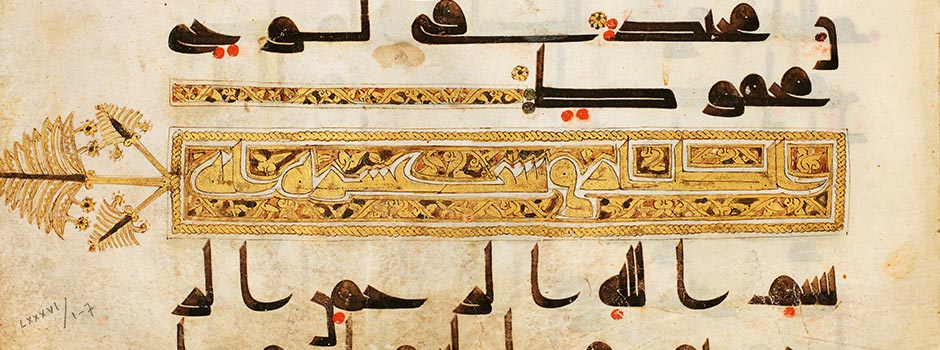
SMITHSONIAN'S SACKLER GALLERY (Oct. 15, 2016 - Feb. 20, 2017) The Art of the Quran: Treasures from the Museum of Turkish and Islamic Arts
Jan 31, 2017 FEATURE, Art Collection

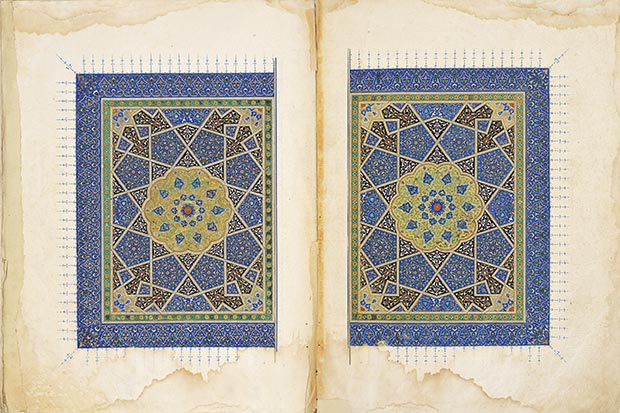 Quran, Afghanistan, Herat, Timurid period. 1434, Ink, colour, and gold on paper. Each page 35.3 x 25 cm / Istanbul, Museum of Turkish and Islamic Arts
Quran, Afghanistan, Herat, Timurid period. 1434, Ink, colour, and gold on paper. Each page 35.3 x 25 cm / Istanbul, Museum of Turkish and Islamic Arts
The first major exhibition of Qurans in the U.S., 'The Art of the Quran: Treasures from the Museum of Turkish and Islamic Arts,' is on view until Feb. 20, 2017. The exhibition is organized by the Sackler in collaboration with the Museum of Turkish and Islamic Arts in Istanbul. It will feature more than 60 of the most important Quran manuscripts ever produced from the Arab world, Turkey, Iran and Afghanistan.
Celebrated for their superb calligraphy and lavish illumination, these manuscripts span almost 1,000 years of history, from 8th century Damascus, Syria, to 17th century Istanbul. Many of the works, which will be on view outside of Turkey for the first time, are critical to the history and appreciation of the arts of the book. This landmark exhibition tells the individual stories of some of these extraordinary manuscripts, their makers and their owners. Visitors will learn how the Quran was transformed from an orally transmitted message to a written, illuminated and bound text produced by highly accomplished artists from the Islamic world.
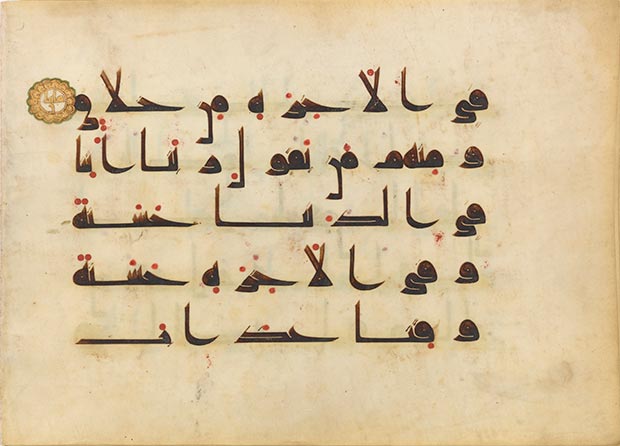 Quran folio, Near East, Abbasid period, 9th-10th century. Ink, colour, and gold on parchment. 24.5 x 33 cm / Purchase Charles Lang Freer Endowment, Freer Gallery of Art
Quran folio, Near East, Abbasid period, 9th-10th century. Ink, colour, and gold on parchment. 24.5 x 33 cm / Purchase Charles Lang Freer Endowment, Freer Gallery of Art
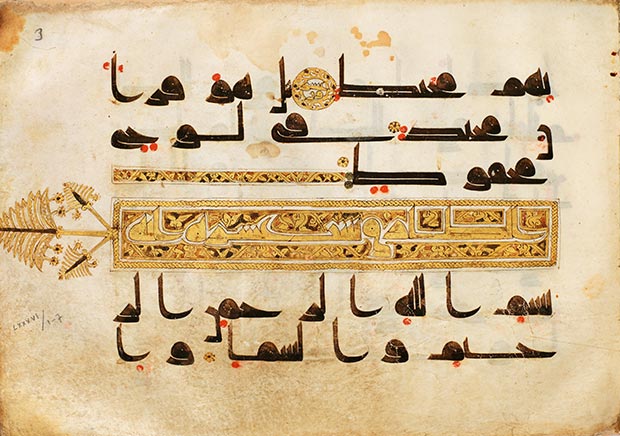 Quran folio, Near East, Abbasid period, 10th century. Ink, gold, and colour on parchment. 20.9 x 28.3 cm / Istanbul, Museum of Turkish and Islamic Arts
Quran folio, Near East, Abbasid period, 10th century. Ink, gold, and colour on parchment. 20.9 x 28.3 cm / Istanbul, Museum of Turkish and Islamic Arts
These Qurans were originally created for some of the most powerful rulers of the Islamic world. As the finest examples of their kind, long after their completion the manuscripts were sought out and cherished as prized possessions by the Ottoman ruling elite, whose power once extended from southeast Europe to northern Africa and the Middle East. They were offered as gifts to cement political and military relationships or recognize special acts, and they were also given to public and religious institutions to express personal piety and secure political power and prestige. Donations of Qurans to libraries and public institutions by royal women expressed their commitment to contemporary religious and social life.
Shortly before 1914, when the Ottoman Empire was in political turmoil, its government decided to transfer to Istanbul all valuable works of art that had been donated to mosques, schools, shrines and other religious institutions across the empire. These included thousands of the most ornate Quran manuscripts and loose folios, which are housed today in the Museum of Turkish and Islamic Arts, located in the heart of the historical city, opposite the so-called Blue Mosque.
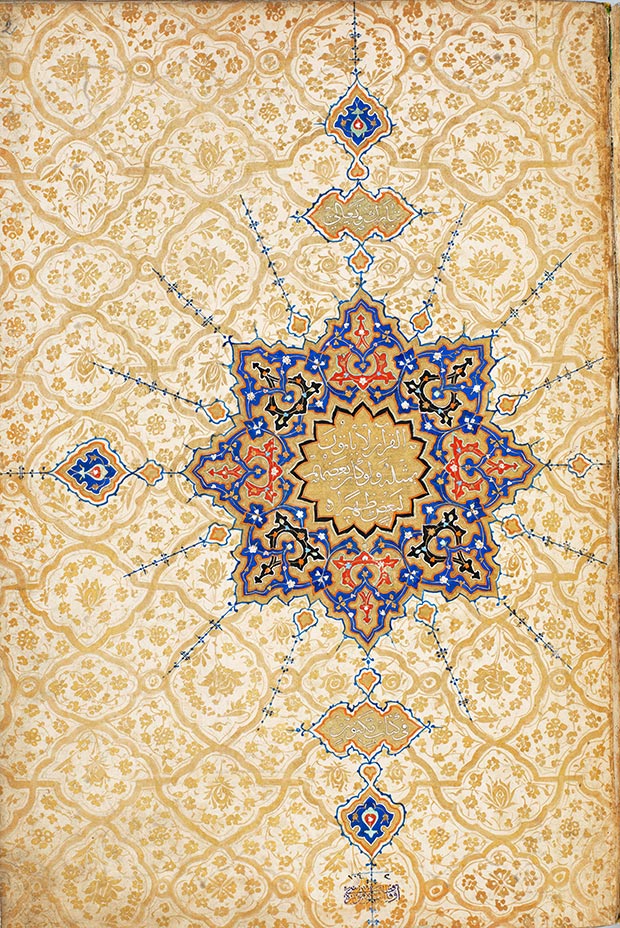 Quran, Afghanistan, Herat, Safavid period, January 1576. Ink, colour, and gold on paper. 34.5 x 24.5 cm / Istanbul, Museum of Turkish and Islamic Arts
Quran, Afghanistan, Herat, Safavid period, January 1576. Ink, colour, and gold on paper. 34.5 x 24.5 cm / Istanbul, Museum of Turkish and Islamic Arts
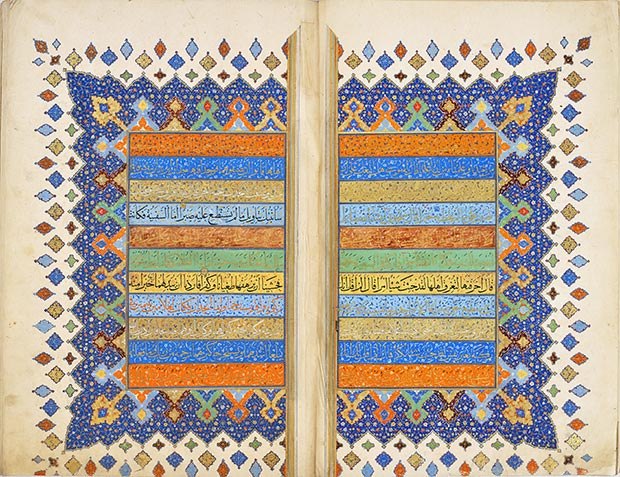 Quran, Calligrapher: Abd al-Qadir b. Abd al-Wahhab b. Shahmir al-Husayni. Iran, Shiraz, Safavid period, ca. 1580. Ink, colour, and gold on paper. Each page 58 x 39 cm / Istanbul, Museum of Turkish and Islamic Arts
Quran, Calligrapher: Abd al-Qadir b. Abd al-Wahhab b. Shahmir al-Husayni. Iran, Shiraz, Safavid period, ca. 1580. Ink, colour, and gold on paper. Each page 58 x 39 cm / Istanbul, Museum of Turkish and Islamic Arts
"This exhibition offers a unique opportunity to see Qurans of different origins, formats and styles and begin to appreciate the power and beauty of the calligraphy as well as intricacy of the illuminated decoration," said Massumeh Farhad, the Freer and Sackler's chief curator and curator of Islamic art. "Although each copy of the Quran contains an identical text, the mastery and skill of the artists have transformed it into a unique work of art."
"The Museum of Turkish and Islamic Arts in Istanbul has one of the most extraordinary collections of Qurans in the world, yet its holdings are little known even to many experts," said Julian Raby, The Dame Jillian Sackler Director of the Arthur M. Sackler Gallery and Freer Gallery of Art. "This exhibition provides an unparalleled opportunity for audiences in the United States to appreciate the artistry of Muslim scribes and craftsmen over more than a millennium, in regions from North Africa to Afghanistan."
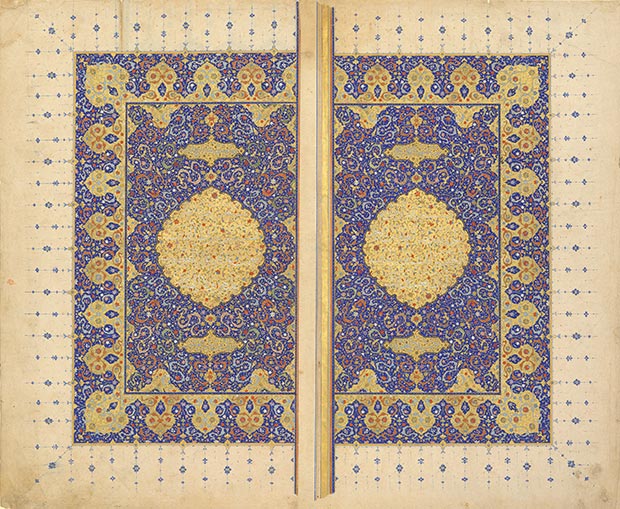 Quran Folios, Iran, Shiraz, Safavid period, ca. 1550. Opaque watercolour, ink, and gold on paper. Each page approx. 42.2 x 25 cm / Purchase Smithsonian Unrestricted Trust Funds, Smithsonian Collections Acquisition Program, and Dr Arthur M. Sackler / Arthur M. Sackler Gallery
Quran Folios, Iran, Shiraz, Safavid period, ca. 1550. Opaque watercolour, ink, and gold on paper. Each page approx. 42.2 x 25 cm / Purchase Smithsonian Unrestricted Trust Funds, Smithsonian Collections Acquisition Program, and Dr Arthur M. Sackler / Arthur M. Sackler Gallery
_Iraq_Baghdad_Il-Khanid_period_1307-8.jpg) Quran (Juz), Iraq, Baghdad, Il-Khanid period, 1307-8. Gold, colour, and ink on paper. 70.8 x 48.5 cm / Istanbul, Museum of Turkish and Islamic Arts
Quran (Juz), Iraq, Baghdad, Il-Khanid period, 1307-8. Gold, colour, and ink on paper. 70.8 x 48.5 cm / Istanbul, Museum of Turkish and Islamic Arts
The Freer and Sackler galleries have one of the most comprehensive collections of Islamic art in the U.S. A number of important Qurans from the museum's permanent collections are on display at the exhibition. A multi-author, full-colour catalogue published by Freer and Sackler features a series of essays on the Quran, its calligraphy, illumination and organization as a text, as well an introduction to the formation of the Museum of Turkish and Islamic Arts. The catalogue also includes detailed discussions of each of the artworks in the exhibition.
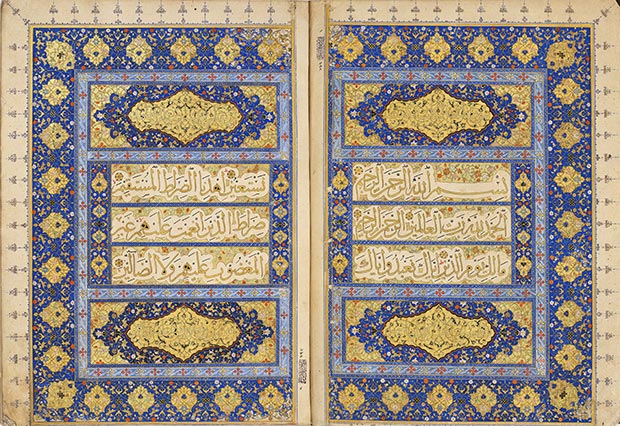 Quran, Calligrapher: Khalil Allah b. Mahmud Shah, Turkey, Ottoman period, September 1517. Ink, colour, and gold on paper. Each page 37 x 29 cm / Istanbul, Museum of Turkish and Islamic Arts
Quran, Calligrapher: Khalil Allah b. Mahmud Shah, Turkey, Ottoman period, September 1517. Ink, colour, and gold on paper. Each page 37 x 29 cm / Istanbul, Museum of Turkish and Islamic Arts
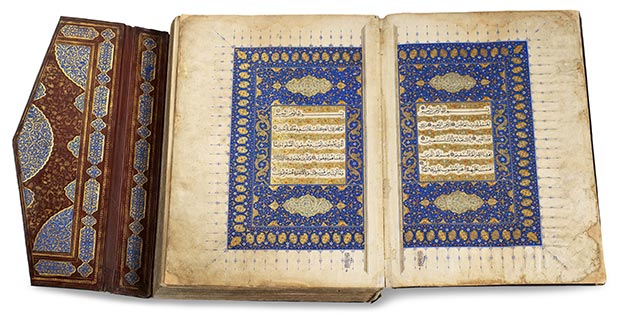 Quran, Calligrapher: Ali b. Mahmud al-Havavi, Iran, Tabriz, Safavid period, January 15, 1516. Ink, colour, and gold on paper. Each page 41 x 29 cm / Istanbul, Museum of Turkish and Islamic Arts
Quran, Calligrapher: Ali b. Mahmud al-Havavi, Iran, Tabriz, Safavid period, January 15, 1516. Ink, colour, and gold on paper. Each page 41 x 29 cm / Istanbul, Museum of Turkish and Islamic Arts
'The Art of the Quran: Treasures from the Museum of Turkish and Islamic Arts' is organized by the Freer and Sackler and the Museum of Turkish and Islamic Arts in Istanbul. It has been curated by Farhad and Simon Rettig, assistant curators at the Freer and Sackler. The Freer and Sackler have presented other major exhibitions featuring important religious objects and publications, including 'In the Beginning: Bibles Before the Year 1000' in 2006 and 'The Tibetan Shrine from the Alice S. Kandell Collection in 2010. The museums most recently collaborated with the Topkapi Palace Museum in Istanbul on 'Style and Status' in 2005.
 Quran, Attributed to calligrapher Abd Allah al-Sayrafi. Probably Iraq, Il Khanid period, the first half of the 14th century. Ink, colour, and gold on paper. 50 x 35.5 cm / Istanbul Museum of Turkish and Islamic Arts
Quran, Attributed to calligrapher Abd Allah al-Sayrafi. Probably Iraq, Il Khanid period, the first half of the 14th century. Ink, colour, and gold on paper. 50 x 35.5 cm / Istanbul Museum of Turkish and Islamic Arts
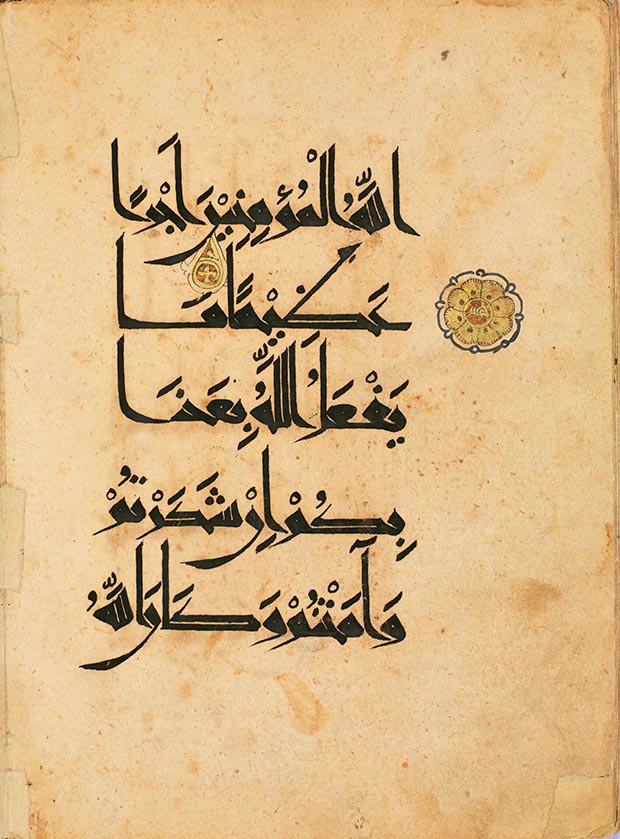 Quran section, Probably Iran, Seljuq period, early 11th century. Ink, colour, and gold on paper, 19 x 14 cm / Istanbul, Museum of Turkish and Islamic Arts
Quran section, Probably Iran, Seljuq period, early 11th century. Ink, colour, and gold on paper, 19 x 14 cm / Istanbul, Museum of Turkish and Islamic Arts
The Smithsonian's Freer Gallery of Art and Arthur M. Sackler Gallery, located on the National Mall in Washington, D.C., together comprise the nation's museum of Asian art. It contains one of the most important collections of Asian art in the world, featuring more than 40,000 objects ranging in time from the Neolithic to the present day, with especially fine groupings of Islamic art, Chinese jades, bronzes and paintings and the art of the ancient Near East. The galleries also contain important masterworks from Japan, ancient Egypt, South and Southeast Asia and Korea, as well as the Freer's noted collection of works by American artist James McNeill Whistler.
Comments
Add a comment